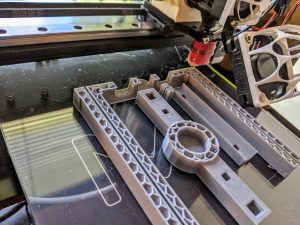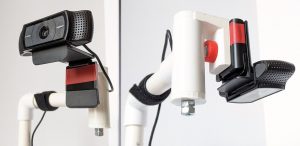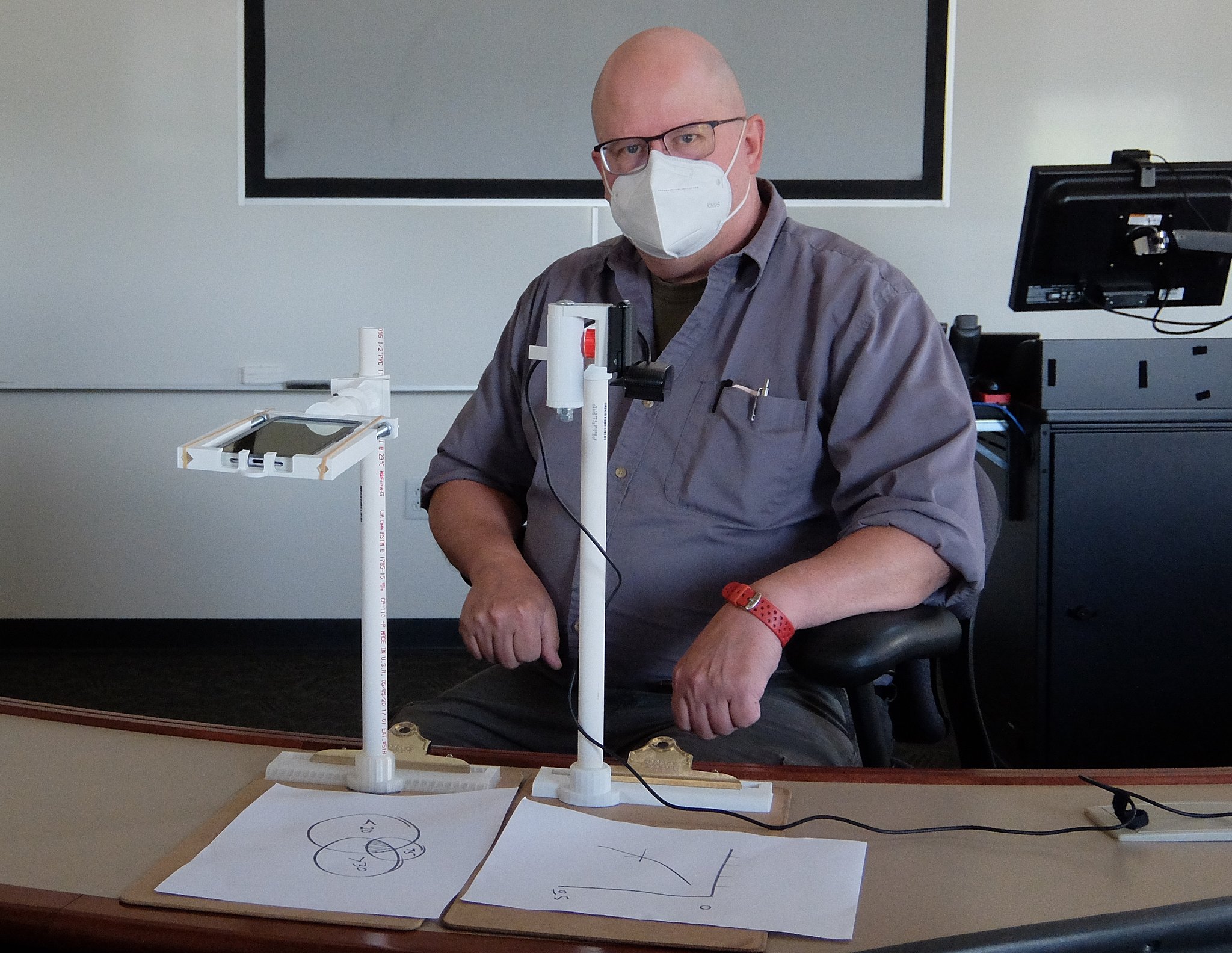Moving higher education to an online environment is not without its challenges, but George Wiman is doing his part to help streamline the process for faculty members in the State Farm Hall of Business by using 3D printers to make practical tools to aid remote instruction.

Parts and construction in making a holder for a smart phone to aid remote instruction.
When Wiman first encountered 3D printing technology about five years ago and saw how it combined electronics, micromechanics, production and design, he knew it was right up his alley. Today, overseeing and maintaining the College of Business’ 3D printing lab is part of his duties as a computer support specialist. He also has taught several semesters of a 3D printing course geared toward business students. In that classroom setting, he enjoyed exploring the opportunities additive manufacturing provides for innovation and how it impacts such areas as digital supply chains and on-demand manufacturing.
As he tells students, one of the strengths of 3D printing is how it can be used to rapidly and inexpensively meet very specific needs. With that lesson in mind, he has spent the last month brainstorming ways to create cost-effective and user-friendly alternatives to the document cameras many professors are accustomed to using in physical classrooms. His idea was to create a “3D printed tripod mount with a swivel on it” that would allow a standard webcam to be turned into a lightweight, portable document camera, which could easily be set up in a home office. Faculty can also use the setup to allow students to see notes and formulas that normally would be written on a whiteboard.
“A webcam can be a perfectly good document camera. It has all the resolution you need. You just need a way to hold it firmly and point it straight down. But then at the same time it needs to turn around and point back up at you so you that can use it as a webcam,” Wiman observed.
He went through several iterations of his design using online software called Tinkercad and came up with two different solutions—one that holds a traditional webcam and another that supports a smartphone. Each of the 3D printed mounts attaches to a simple PVC stand that provides vertical support.
“A co-worker suggested that anything I create should be able to be assembled in a library by volunteers, so that rules out a lot of machining,” Wiman said. “It rules out most of the equipment in my wood shop and my machine shop. That’s all out. So what’s a good base? Well, it turns out they make them and sell them at office stores for three bucks.”
Laughing, he held up a clipboard and demonstrated how it holds the stand design in place and provides stability as well as a surface on which to display papers.

A webcam being used as a document camera to aid remote instruction.
Like the webcam stand, his phone mount also swivels so it can be used as a document camera or for Zoom meetings. He described the design as “very robust” and added “it will not drop your phone.” It also adjusts to fit any phone size.
“About a dozen (faculty members) so far have requested these document cameras and the requests are still coming in,” Wiman reported.
Since developing his initial design, the technician has made changes to the base for better stability and created a connector that allows the height of the camera to be adjusted.
This ability to make continuous improvements to a design is one of the strengths of 3D printing that Wiman particularly appreciates. As he explained, this versatility has big implications for business in areas such as supply chain, prototyping, developing, and marketing.
“You can do a prototype in an afternoon that would have taken committee meetings and a machinist and so on months to get on the table,” he observed. “Because it’s working from a digital file, you can make one of (your design). You can customize something; where if you had to injection mold something … that’s a big lead time and financial investment to make that object if you need to change it.”
He also is fascinated by the wide array of fields that can benefit from using 3D printing. For instance, it has applications in such diverse areas as architectural modeling, urban planning design, aerospace, and medicine. In relation to this latter field, he referenced efforts to use the technology to make low-cost bionics for people who need prosthetics and how a group in Africa developed a folding 3D printed field microscope for use in diagnostics.
“I’m very big on solving problems with design,” Wiman said before describing how over the last few years he has created 3D print items to meet several needs within the College of Business. His innovations include caddies to hold remote computer mice and a modification involving an embedded magnet for the handicap bathroom stall doors so they do not open by themselves.
In response to the coronavirus pandemic, Wiman also developed a 3D printed hand sanitizer bottle filling station, and in the spring the COB’s five 3D printers joined others across campus in making hundreds of components for face shields that were delivered to the McLean County Emergency Management Agency. Milner Library spearheaded the latter project.
“When COVID came along, we had these 3D printers. We put them to work to meet the need, which is just what that kind of technology is good at,” observed Wiman, who is glad to be doing something to help with the current situation and has had fun using his creativity to solve practical problems.
COB faculty can request a webcam or phone stand by contacting the Faculty Resource Center. Also, the digital 3D print files for the document stands are available for download at about.illinoisstate.edu/gawiman.
“I’m very happy to help anyone get geared up to produce them themselves. They’re not hard to make,” concluded Wiman.

